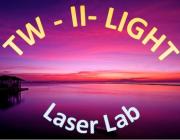Trains of attosecond bursts of light are presently attainable through high harmonics generation (HHG) [1, 2]. However, to produce isolated single attosecond pulses for time-domain spectroscopy, it is crucial to lock the carrier to envelope phase (CEP) of the HHG driving laser [3–5]. With current technology, which is mainly based on Ti:Sapphire lasers that work at a carrier wavelength of ~800nm, the HHG photon-energies are limited to ~150 eV. However, many applications will beneft from much higher photon-energies, extending into the soft x-ray [6]. The Process of HHG is easily understood within the framework of the well-known three-step model of HHG [7, 8]. According to this model, the cutoff energy of the high harmonics spectrum scales with the square of the carrier wavelength of the HHG driving light source [9–12]. Thus, a laser drive with a longer wavelength would be able to produce HHG with more energetic photons. Ultrashort mid-infrared (MIR) pulses are highly regarded in research areas such as molecular spectroscopy [1,2], coherent control of chemical reactions [3,4], remote sensing [5], and other high filed physics (besides HHG).
In the past, due to the lack of laser materials with a broad enough gain spectrum in the infrared, optical parametric amplifers (OPAs) and optical parametric chirped pulse amplifers (OPCPAs) were the only alternatives for the generation of ultrashort pulses in this spectral range. The unfortunate situation of unavailability of large gainbandwidth laser materials in the infrared is now changing [18–23]. Particularly attractive for ultrafast pulse generation and amplifcation are the divalent chromium-doped chalcogenides, specifcally Cr:ZnSe and Cr:ZnS. These materials have an extensive gain bandwidth (>500nm), which perfectly overlap the atmospheric transparency window between 2 and 2.5 µm in the mid-IR.
In our lab, we are developing two femtosecond lasers systems based on Cr:ZnSe and Fe:ZnS.

